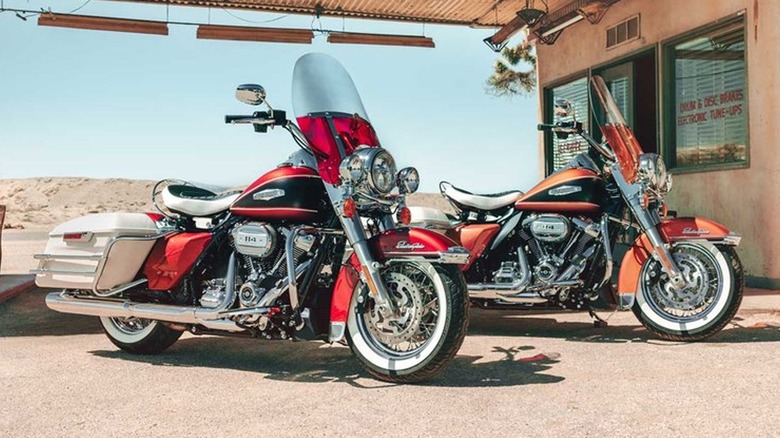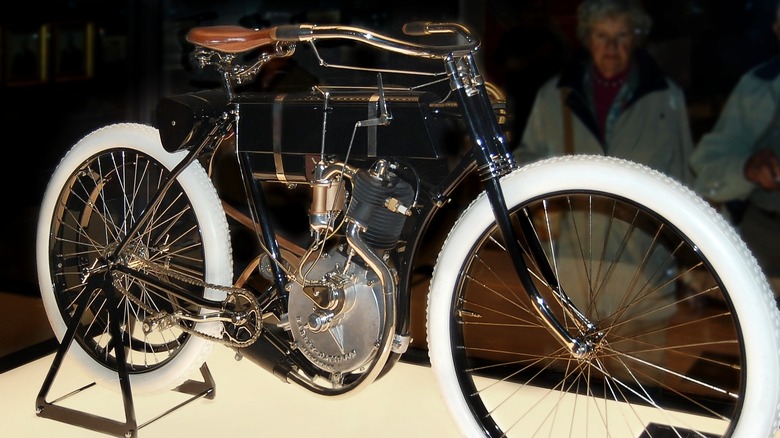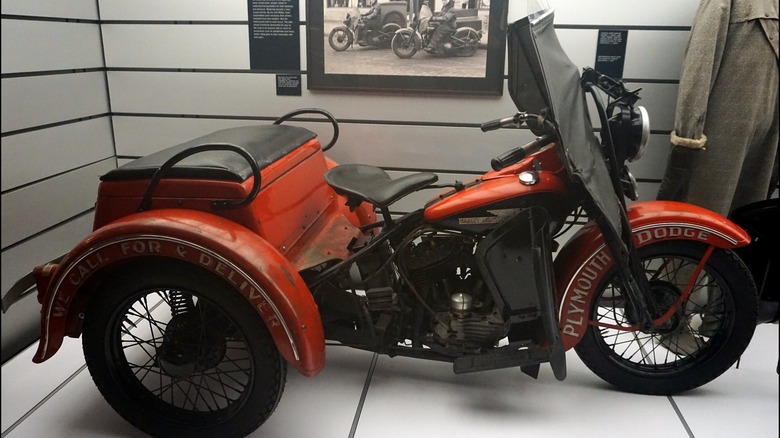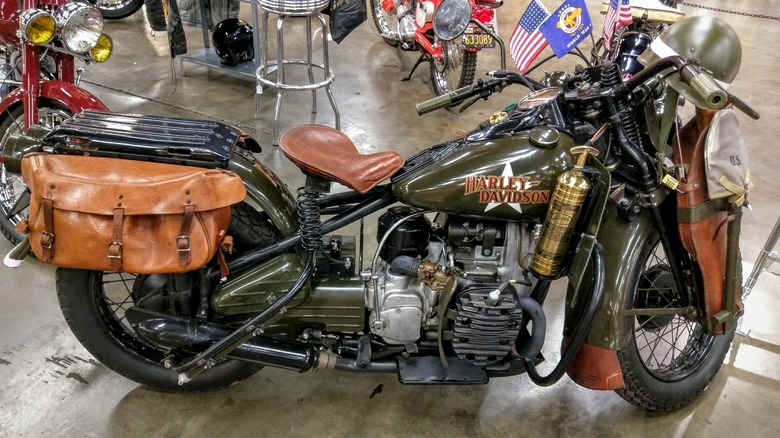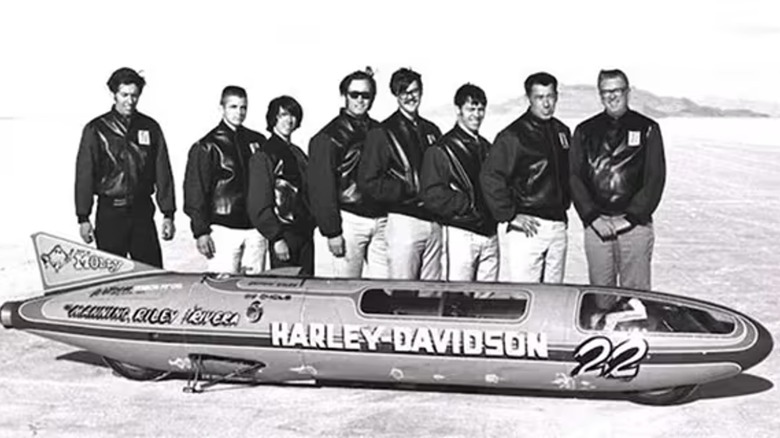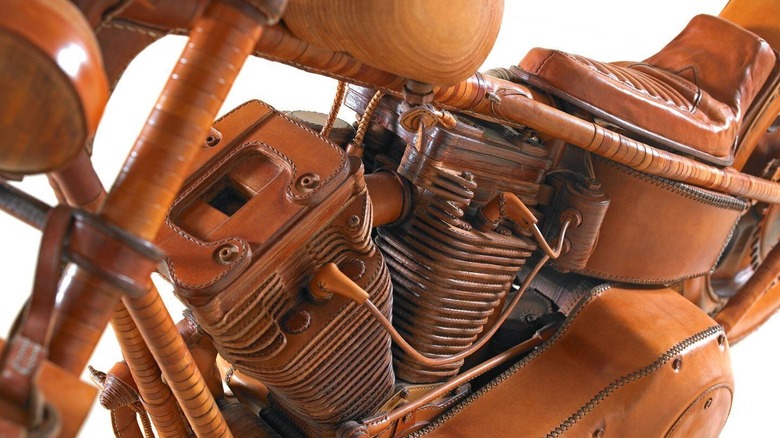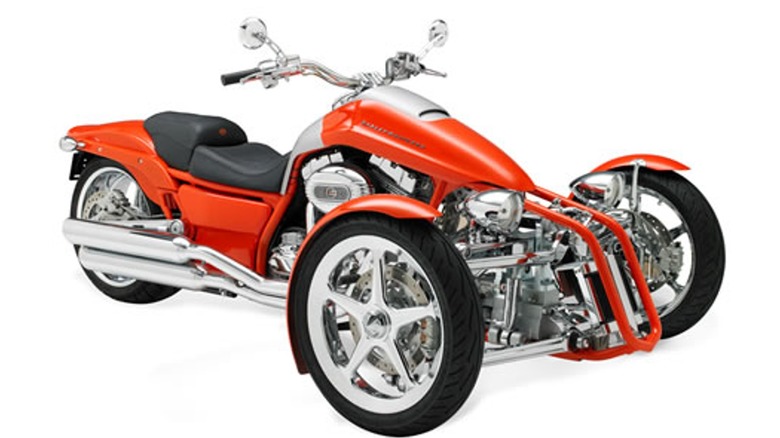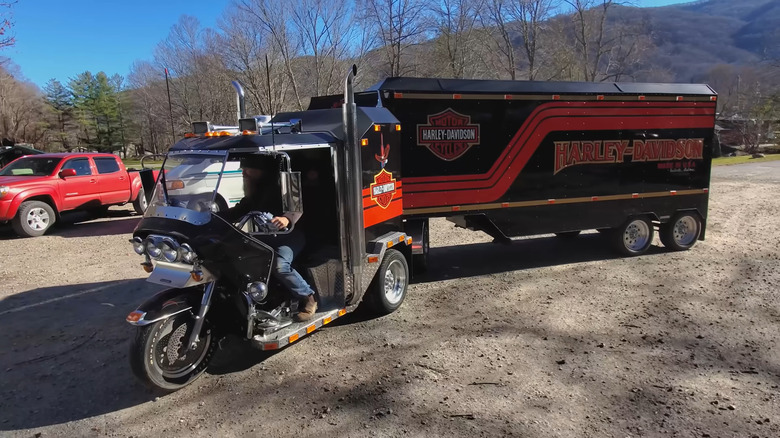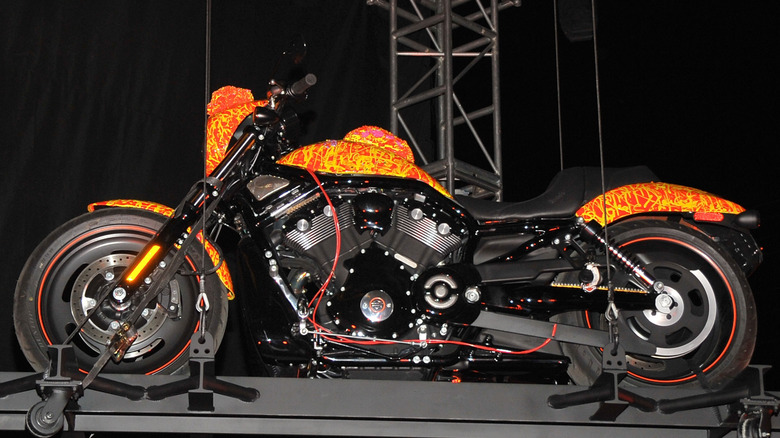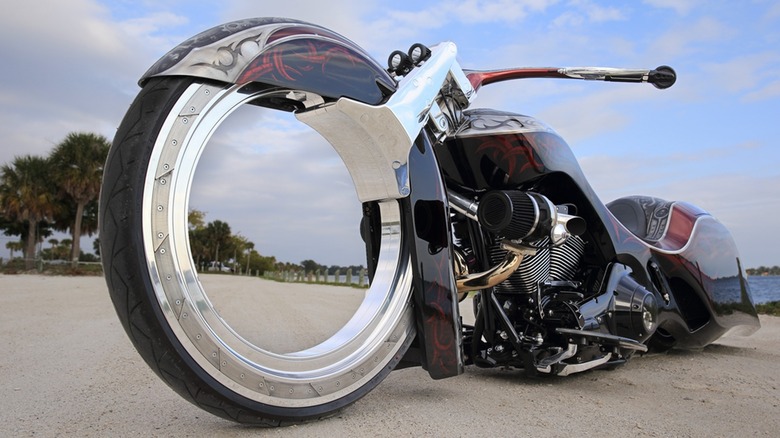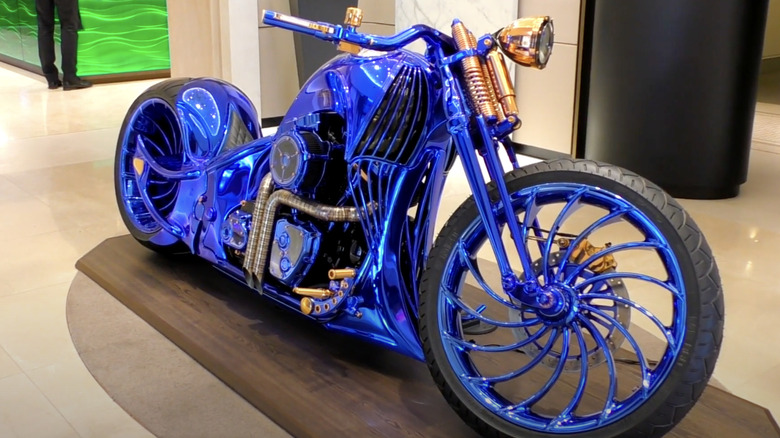10 Of The Strangest Harley-Davidson Motorcycles Ever Made
Few companies are as tied into American motorcycle culture as Harley-Davidson. When most people hear the word "motorcycle," they probably think of something like Harley-Davidson's Sportster thanks to its iconic shape and stellar performance. To be fair, the Sportster is one of the company's best motorcycles and has been since the 1950s. But not all Harleys look like your standard motorcycle gang conveyance.
Truth be told, the company has manufactured plenty of stylish motorcycles, some of which wouldn't look out of place in a Yamaha or Kawasaki lineup. There are even a few exceedingly rare Harley models that challenge what it means to be a motorcycle. However, most of these choppers have nothing on Harley-Davidson's strangest products. The company's list of oddities includes vehicles that helped users haul luggage during the great depression, a motorized missile designed to break speed records, and more than a few prototypes that never made it to production. There are even one-of-a-kind art projects that belong in a museum, rather than on a highway.
Here are 10 of the wildest and wackiest motorcycles to ever bear the name "Harley-Davidson."
Harley-Davidson Single (1903)
The first motorcycle ever produced was little more than a motorized wooden bicycle, but the Daimler Reitwagen still paved the way for modern motorcycles. Harley-Davidson's first motorcycle only slightly improved on that design.
The 1903 Harley-Davidson Single is one of the rarest motorcycles ever built by the company. It was also the first, which is why an alternative name for the motorcycle is "Harley-Davidson Serial Number One." The Single doesn't look like your average motorcycle. Instead, it looks like a standard pedal-powered bicycle with an engine attached to it. Because that's precisely what it is.
In truth, the "Harley-Davidson Single" was originally just an engine that William S. Harley designed to fit on a normal bicycle. The final product eventually evolved into its own custom bike, but at the end of the day, it was still an amalgamation of foot pedals, flywheels, and an engine. Harley and his friend Arthur Davidson didn't even have money for a proper factory; they built their first motorcycles in a tiny wooden shed. Still, what the pair lacked in funding they made up for in moxy. The bicycle-like Harley-Davidson Single won plenty of races, as well as the hearts of everyone who saw it. Without this initial low-tech design, there probably wouldn't be a Harley-Davidson company today.
Servi-Car (1932-1973)
The Great Depression was one of the worst periods in recent human history. The global economy collapsed, and most countries were only able to dig themselves out of their economic sinkholes because World War II rekindled numerous manufacturing plants. Before that happened, some companies tried to adapt by producing products that expanded their utility and target demographics.
Harley-Davidson's Servi-Car was introduced in 1932, three years after the start of the Great Depression. Unlike most of the company's prior motorcycles, the Servi-Car was designed with utility and commercial purposes in mind, hence its hauling capabilities, storage compartment in the back, and front tow bar. Of course, to make room for the rear trunk, Harley-Davidson widened the back and turned the motorcycle into a tricycle. This design had the added advantage of increasing the Servi-Car's user base — anyone could drive and balance on it regardless of their motorcycling experience.
One of the Servi-Car's most popular applications was car delivery. All someone had to do was hitch the motorcycle to the rear of a car, drive the automobile to its intended recipient, unhook the Servi-Car, and drive it away. Harley-Davidson's Servi-Car proved so popular that it outlived the Great Depression, World War II, and most of the Vietnam War. Harley-Davidson finally discontinued its odd motorized tricycle in 1973, making it one of the company's longest-running products.
Harley-Davidson XA (1942)
War is an industry unto itself. In order to win battles and support troops, factories have to churn out weapons, ammo, and vehicles. During World War II, many companies like Chrysler switched from building cars to constructing planes, tanks, and turbine engines. Meanwhile, Harley-Davidson's engineers continued focusing on what they do best.
Unlike most entries on this list, the Harley-Davidson XA (Experimental Army) isn't unusual because of what it looked like but how it functioned. In order to support U.S. troops across the globe, Harley-Davidson manufactured motorcycles that could operate in different biomes, most crucially the deserts of North Africa. To this end, the XA adopted a flat-twin engine layout to provide superior cooling, and instead of using an exposed chain to drive the rear wheel, the XA employed a shaft, which reduced maintenance downtime and kept out dust and other debris.
One of the Harley-Davidson XA's main influences was ironically its main rival: BMW's R71 motorcycle. These vehicles were a mainstay among Nazi Germany's invading forces, and used features such as a flat-twin engine and shaft drive to outperform Harley-Davidson's prior military motorcycle, the WLA. To compete with the R71, Harley-Davidson stole its ideas — all is fair is love and war, after all. Sadly, the XA never made it past the testing phase; the U.S. Army opted to buy more WLAs.
Sportster Streamliner (1970)
It doesn't matter if they're trying to build the fastest supercars on the planet or beat video games in record times, some people just have an instinctual need for speed. Harley-Davidson has a long history of scratching that particular itch.
The Bonneville Speedway, also known as the Bonneville Salt Flats Race Track, is a popular location for motor sports enthusiasts and professionals. Every year, people gather to try and set land speed records, and in 1970, motorcycle racer Cal Rayborn did just that using a streamliner powered by a Harley-Davidson Sportster engine. For those who don't know, a streamliner isn't a specific classification of a vehicle but instead a general shape designed to reduce air resistance. If you've ever seen a train with an art deco design, you've seen a streamliner. Technically, bullet trains are also streamliners.
Rayborn's vehicle, simply known as the Harley-Davidson Sportster Streamliner, barely looked like a motorcycle. If anything, it was more akin to a missile on two wheels. Thanks to the Sportster Streamliner's unusual design — and fuel consisting of 70% nitro-methane — Rayborn was able to set a land speed record of 265.492 mph, beating the prior motorcycle land speed record of 245.667 mph. This new record remained intact until 1975.
Red Moon Evo Chopper (2000)
No two people agree on the definition of art since, quite ironically, almost everyone agrees that art is subjective. To some, art is limited to the paintings and sculptures one finds in a museum; but to others, video games such as "Ico," "The Stanley Parable," and "Okami" are an interactive form of art. More than a few enterprising designers believe motorcycles can be art.
During the summer of 2011, the Harley-Davidson Museum opened a collection of Ripley's Believe It Or Not-style oddities to the public. Dubbed "Collection X," this exhibit housed numerous rare prototypes of Harley-Davidson motorcycles, as well as several art projects built using Harley-Davidsons. While you can't see Collection X in person anymore, sites such as CNET posted images of its most noteworthy inclusions for the sake of posterity. One of the strangest items on display was a leather-bound motorcycle.
The 2000 Red Moon Evo Chopper was built using a 2000 Harley-Davidson Evo Chopper — the "Red Moon" in its name came from the Japanese company that customized the motorcycle, Red Moon. This studio specializes in leather products, so 20 of Red Moon's employees hand-stitched and wrapped everything from the handlebars down to the wheels in leather, essentially turning the vehicle into a tanned mummycycle. The process took two years, and since every inch of the motorcycle is covered in leather, you can only display the piece, never ride it. Well, you could ride the Red Moon Evo Chopper, but why would you want to ruin all that beautiful leather?
Penster Prototype
Traditional logic states that tricycles should have one wheel in the front and two in the back. This usually stays true for three-wheel motorcycles, but every now and then a company bucks the trend. The Can-Am Spyder and Ryker are examples of motorcycles that boast this reverse-trike design, and Harley-Davidson has experimented with it, too.
The Penster Prototype is yet another piece of Harley-Davidson history from the aforementioned Collection X. This experimental design features two wheels in the front and one in the back. The layout is already strange enough and makes the Penster look like a hot rod of a motorcycle, but Harley-Davidson added yet another feature to the design in the form of a tilting front end. Each wheel has extra suspension to keep the motorcycle fairly upright regardless of a turn's sharpness, not unlike the Piaggio MP3. Harley-Davidson also filed a patent for hydraulic actuators on the Penster's wheel tilts. This addition was supposed to help straighten the bike after turns.
While the Penster Prototype never made it into production, Harley-Davidson has made several other trikes, including the Tri-Glide and Freewheeler motorcycles. Although, even though the Tri-Glide and Freewheeler have quite a few differences, they have more in common with the Servi-Car than they do with the Penster since they follow the traditional trike body plan.
The KennyBilt
After you purchase a motorcycle, how do you get it back to your house? Do you drive it off the lot, or do you have it delivered via truck? How about having a Harley deliver your Harley — one motorcycle customizer imagined what that could look like.
In 2022, the motorcycle collectors behind the Wheels Through Time YouTube channel got their hands on the KennyBilt. At first glance, this vehicle looks like a small Harley-Davidson tractor trailer, but when you look at the front cab, you see it's actually a Harley-Davidson motorcycle inside a shell meant to like a tractor trailer. This rig might have nine wheels, but it also retains its original motorcycle's handlebars, complete with odometer. The KennyBilt was built by Kenny Kilpatrick in 1989 and went on several cross-country tours. Oddly enough, some people have posted what looks like the KennyBilt on the WeirdWheels subreddit, but this vehicle has what looks like two motorcycle wheels in the front instead of one. No idea if it's a recreation or modification.
Admittedly, this isn't the first time a Harley-Davidson truck hit the road. In 1913, the company produced a "Motorcycle Truck," which looked like a cross between the Harley-Davidson Single and the Servi-Car. However, that Motorcycle Truck was an official Harley-Davidson product, whereas the KennyBilt was a unique custom job. If we had to pick which one looks stranger, it would be the KennyBilt since it actually looks like a miniature tractor trailer.
Harley-Davidson Cosmic Starship
In the world of art, every creative mind has their preferred medium. Some stick to paint or stone, but other artists use more unorthodox canvases. One such person used a Harley-Davison to create art, but what else can you expect from a friend of Andy Warhol?
American artist Jack Armstrong (nephew of Neil Armstrong) once turned a 2002 Harley-Davidson V-Rod into a work of art. Unlike most custom bikes, Armstrong didn't add or change any major components to alter the motorcycle's performance; all he did was paint certain parts in his signature "Cosmic Extensionalism" style. The result, dubbed the "Harley-Davidson Cosmic Starship," made the V-Rod look like an '80s hair metal band in motorcycle form.
Unlike most motorcycle art projects, the Cosmic Starship is completely functional as a fully drivable motorcycle. Good luck taking this one for a spin, though. In 2012, the Cosmic Starship sold for $3 million, and Armstrong bought it back in 2022 — sort of. He actually traded a painting titled "Star Key #733" for it, but that painting had an estimated value of $50 million, so he basically paid that much money to regain his custom motorcycle. Despite money not actually exchanging hands, many motorcycle enthusiasts consider the Cosmic Starship to be worth $50 million, making it one of if not the world's most expensive custom motorcycles.
Hubless Harley-Davidson
It feels like every time a motorcycle shows up in a sci-fi setting, it's hubless and has tires that rotate around a ring like a ball bearing (or fidget spinner). Some of the strangest concept motorcycles ever designed brought this eccentric look to reality, and not one of them was a Harley-Davidson. It fell to motorcycle customizers to rectify that.
The hubless Harley-Davidson isn't a specific customization so much as it is a classification. One of the first people to produce a hubless Harley was Howard Sofield of Howard's Killer Custom. He converted a 1969 FL Harley-Davidson into a motorcycle without spokes. Technically, it had a spoked wheel in the front and a hubless one in the back, and the result was certainly eye-catching. But Howard's Killer Custom isn't the only name in the hubless Harley game.
In 2014, Ballistic Cycles unveiled its take on the hubless motorcycle design. Unlike Sofield, this group of customizers used a bagger Harley-Davidson (a large, touring motorcycle) to produce a custom hubless vehicle. This custom job was christened the "Hubless Harley-Davidson Road King." While Ballistic Cycles wasn't the first to create a hubless Harley, the team was definitely the first to add a 30-inch front wheel to a bagger motorcycle. But the customizers didn't stop there. Ballistic Cycles kitted out their creation with an all-aluminum body and an utterly amazing paint job featuring H.R. Giger skull faces. The motorcycle looks like it drove out of "Final Fantasy XV."
Harley-Davidson Bucherer Blue Edition
While most luxury vehicles are cars, this specially made Harley-Davidson epitomizes excess and caters exclusively to the ultra-rich. And fans of the color blue.
The Harley-Davidson Bucherer Blue Edition was made as a collaboration between Harley-Davidson and the Swiss watch and jewelry manufacturer Bucherer. That's right, this all-blue bike isn't a custom job but a one-of-a-kind official Harley-Davidson motorcycle. The bike began life as a Softail Slim S, and six craftsmen spent over 2,500 hours to transform the motorcycle. Some sources claim that as many as eight people worked on the bike.
As its name suggests, the Bucherer Blue Edition is painted in Bucherer's trademark shade of blue, but that's not all. The bike is dotted in 630 diamonds, houses two armored safes on each side of its tank, and is covered in handmade metal parts sheathed in 24-carat gold for an extra layer of extravagance. As of 2020, the Harley-Davidson Bucherer Blue Edition was valued at just under $2 million. Admittedly, that isn't as much as the Harley-Davidson Cosmic Starship, but it still earned the Bucherer Blue Edition the honor of being the most expensive motorcycle ever produced by an established company.
